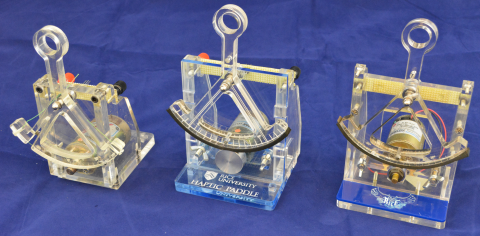Submitted by Marcia O'Malley on

The primary goal of the Haptic Paddle is to improve learning outcomes in a required undergraduate mechanical engineering course via reflective learning featuring integrated systems [1]. The labs integrate haptic technology, LabVIEW, MATLAB simulations, and system interfacing in experiments to enhance understanding of dynamic systems and controls. The specific objectives of the Haptic Paddle-centric lab curriculum are:
- Improve cohesiveness of lecture and lab content and consequently, deepen student conceptual understanding of system dynamics concepts
- Complete the experiential learning cycle and provide reflective learning opportunities
- Improve understanding of critical system dynamics topics in a cost-effective way
Following devices implemented at several universities, the Rice University Haptic Paddle was developed in 2006 [2]. After 6 years of implementation, the Paddle underwent a successive redesigns led by undergraduate researchers Folasade Oba (v. 2012) and Jared Elinger (v. 2014). The primary design changes from the first version of the Haptic Paddle include using a robust ‘friction drive’ instead of a capstan-cable transmission to provide simplicity and improved reliability and the implementation of the National Instruments LabVIEW and myDAQ and myRIO. The myRIO product launch video is included at the bottom of this page.
After a semester testing the redesigned Rice Haptic Paddle (v. 2012), a time and frequency domain device characterization was performed, comparing the two previous devices (v. 2006 and v. 2012), validating their use as haptic teaching tools [3]. The results of this characterization, along with a season of undergraduate use in the MECH 343 teaching lab, has prompted a few design tweaks (v. 2014), focused on improving the robustness machine screws, improving interfaces between the friction drive and attachments, which improve the robustness of the paddle but slightly increase complexity and cost.

The laboratory exercises implemented at Rice are available on this page and have the following structure:
- Introduction to Hardware (Lab 0): This introductory lab focuses on familiarizing students with lab safety procedures, best practices, and equipment, including basic breadboard circuit prototyping.
- Haptic Paddle Introduction and Sensor Calibration (Lab 1): Haptic paddle kits are distributed, and the Hall-Effect sensors are calibrated, complementing linearization lecture materials. Additionally, simple system identification experiments are conducted to experimentally determine the motor torque constant and the inertia of the paddle handle.
- First and second order analog electrical systems (Lab 2): Students get hands on experience with the step responses of first and second order systems, making connections between analogous first and second order mechanical and electrical systems
- Operational Amplifiers (Lab 3): Students are introduced to operational amplifiers as a part of the integrated systems approach of the lab.
- Haptic Paddle – Actuator Characteristics (Lab 4): Students conduct motor spin down tests to determine motor damping, and a step response to determine the damping in the transmission. By combining this information with the experimentally determined values from Lab 1, students complete a second order model of the haptic paddle.
- Haptic Paddle – Virtual Systems and Teleoperation (Lab 5): Students conduct experiments with second order systems, virtual environments, and teleoperation, with an introduction to feedback control.
The latest development in the haptic paddle is the development of a module, a Haptic Ball and Beam, which can be added to the haptic paddle base [4]. This module adds a dynamic plant for teleoperation demonstrations with the haptic paddle, a multi-input plant for implementing more complex control structures, and a testbed for haptic motor learning experiments in undergraduate coursework.
The bill of materials and CAD files are open source and available to the right of this page.
The posted information has been updated, and reorganized for clarity.
- For information about building the Rice Haptic Paddle, see "Assembly Guide" and "Bill of Materials".
- For information concerning current laboratory procedures, see folder entitled "Rice Haptic Paddle Labs". For solution material, please contact Chad Rose or Craig McDonald.
- For supplemental Solidworks and Adobe Illustrator Files, see folder entitled "Haptic Paddle 3D Modeling".
- For information concerning past haptic paddle designs, see folder entitled "Previous Rice Haptic Paddle Designs". This folder contains all previously posted information from this page.
References
[1] Rose, Chad G., Craig G. McDonald, Janelle P. Clark, and Marcia K. O'Malley. "Reflection on System Dynamics Principles Improves Student Performance in Haptic Paddle Labs," IEEE Transactions on Education, 2018.
[2] Bowen, Kevin, and Marcia K. O'Malley. "Adaptation of haptic interfaces for a labview-based system dynamics course." Haptic Interfaces for Virtual Environment and Teleoperator Systems, 2006 14th Symposium on. IEEE, 2006.
[3] Rose, Chad G., James A. French, and Marcia K. O'Malley. "Design and characterization of a haptic paddle for dynamics education." Haptics Symposium (HAPTICS), 2014 IEEE. IEEE, 2014.
[4] Rose, Chad G., Nathan L. Bucki, and Marcia K. O'Malley. "A Ball and Beam Module for a Haptic Paddle Education Platform," ASME Dynamic Systems and Controls Conference (DSCC). ASME, Tysons, VA, 2017.
